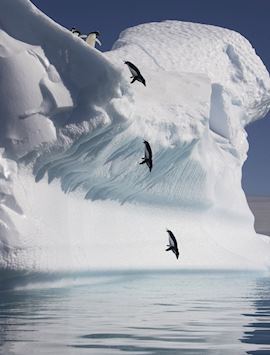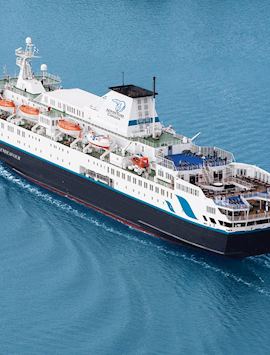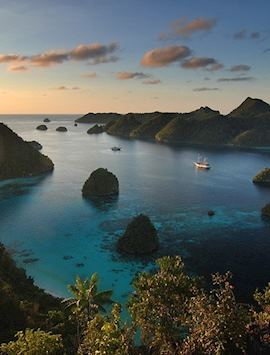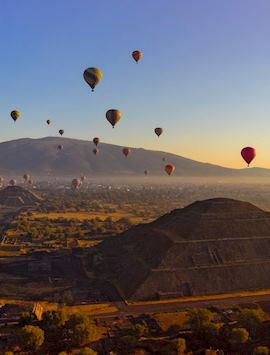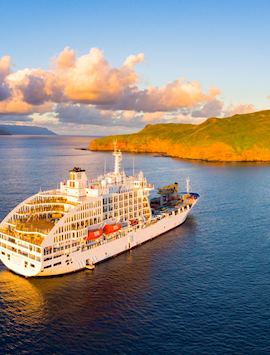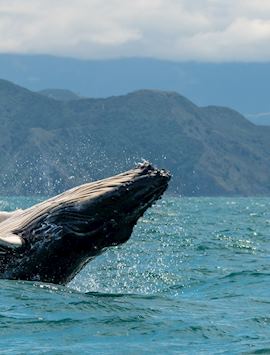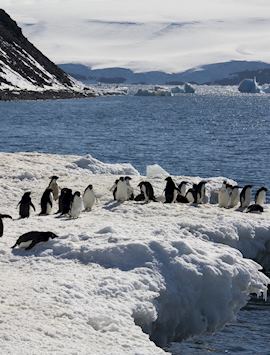By Cruise specialist Caroline
Here’s the thing about expedition cruises: they’re addictive. Go on one, and you’ll be hungry for more, eager to see for yourself some of the planet’s least-visited places. They’re like a shot of adrenaline for me — I like cruising full stop, but no other type of voyage gets you as close to unpeopled landscapes or feeds your curiosity about the world’s wildlife and habitats as expedition cruises. But what are they, where can you go, and — last but not least — what are muck boots and why do you need them?
From the polar regions to Amazon rainforest tributaries, there are certain things it’s important to know about expedition cruises, and I’ve touched on as many frequently asked questions as possible.
What’s an expedition cruise, and how is it different from other cruises?
The main difference, I’d say, is that on an expedition cruise you’re going to places that you can only see by water, on a ship — places like the Antarctic Peninsula, the Northwest Passage, and the smaller archipelagos of the Galapagos Islands where there are few, if any, traces of human habitation. Although land travel is possible (barely) in some of these places, by far the best way of seeing these destinations is by expedition cruise.
You also bring a certain mentality to expedition cruises: you’re there to learn. You’re experiencing and learning about a certain environment, its flora and fauna, and there are lots of expert lectures on board that are specifically focused on the destination you’re visiting. You’re with likeminded people, too, which is great — everyone is there because they’re looking to immerse themselves in these wild places and absorb all they can.
They’re also much busier, day-to-day, than more traditional cruises, where there are usually lots of opportunities to relax alongside exploring. On an expedition cruise you’re up and out every day, disembarking to observe wildlife, walk, and generally soak up these watery wildernesses.
There’s one more key thing to know about expedition cruises — itineraries aren’t fixed (apart from in the Galapagos Islands, where your ship needs to adhere to strict timings). This is because you’re visiting remote places with unpredictable weather.
In the polar regions, ice and sea conditions will affect where you go and what you do. You’ll receive a briefing from expedition leaders each night on where they hope to go the next day, and then that will be updated if the weather decides not to play ball.
Don’t worry about this, though. Accepting that plans change is all part of expedition cruising, and your leaders are always looking for you to see and experience as much as possible. And, most expedition cruisers, myself included, have stories about how plans and routes got diverted — and then they ended up having an extraordinary wildlife sighting, or some other serendipitous moment.

Where can you go on an expedition cruise?
The polar regions are perhaps the obvious candidates, but there are increasing opportunities for warm-water expedition cruises, too. You can explore uninhabited Indonesian island collections like Raja Ampat, or spot grey and blue whales off Baja California in Mexico. You can explore the extremely remote Outback coastline of Australia’s Kimberley region or cruise Peru’s northern Amazon, or venture to the Marquesas Islands of French Polynesia in the South Pacific — we’re talking barely-dots-on-a-world-map kind of places.
And, the possibilities for colder-climate expedition cruises are expanding all the time, too, including routes around Greenland . There are also ships that explore the icescapes of Patagonia’s Tierra del Fuego, and a cruise departing from New Zealand which takes you to some far-flung subantarctic islands.
How long does an expedition cruise last? Are they longer than traditional cruises?
Not necessarily — for example, you can fly to King George Island in the South Shetland Islands from Chile, and embark on a seven-night cruise in Antarctica. But, you can also go on adventures like a Northwest Passage cruise which takes at least 30 days. It’s very dependent on your destination and preferences, but there are lots of different durations.
How big are expedition cruise ships? How do they differ from ocean cruise ships?
These ships are generally much smaller than ocean cruise ships. There are usually around 100 to 200 passengers on an Antarctic or Arctic cruise, whereas in the Galapagos Islands you can have as few as 16 passengers and a maximum of 100. Obviously those vessels are simpler in terms of their on-board facilities, but they’ll all be very comfortable and not Spartan as you might expect.

Where do expedition cruise ships moor?
Depending on the location, they can dock in ports, like the Falkland Islands’ Port Stanley or Spitsbergen’s Longyearbyen. Because the remote places you’re visiting often don’t have man-made or commercial ports, they’ll moor offshore and you’ll take tenders or inflatable boats (which are called Zodiacs on many expedition cruises) to reach shore, or disembark from the ship and explore the surrounding waters.,
In the Galapagos Islands nowadays, the newer ships have anchorless technology, which means they won’t damage reefs or the seabed when they moor out in bays; they use boosters instead. You’ll usually then take pangas (a type of tender used in Latin America) to reach areas of individual islands.
What can I expect day-to-day on an expedition cruise? And what activities are available?
Day-to-day on an expedition cruise is all about getting off the ship on either dry or wet landings (i.e. exploring ashore or going out to take in the scenery on inflatable boats). You’ll be in small groups with an expedition leader who will talk you through all you’re seeing, give context, and help you spot wildlife. You might, alternatively, go off with a guide to snorkel, kayak or paddleboard.
On land, you might take part in a short guided walk or longer trek, or simply be given time to roam a designated area in your own time. Your ship’s crewmembers will be stationed at intervals throughout the area you’re exploring, and will tell you all about an aspect of the environment you’re in — from birdlife to the history of a whaling station to the geology of the beach and the volcanic sands you’re standing on. Wherever you are, they’ll help root you in your destination, pointing out intriguing features and what to look for.
When it comes to what you can expect on board on your ship, you might be pleasantly surprised. Maybe you’ve been picturing a weather-beaten old Soviet icebreaker (and they do exist), but expedition cruise ships these days offer plenty of creature comforts while being high-tech and custom-built for the destinations you’re exploring.
You can expect most of the same facilities you’d find on traditional cruise ships, including a library, guest lecturers and speakers, sometimes swimming pools, multiple restaurants, hot tubs, spas, and saunas.
The one thing expedition cruise vessels usually don’t have is lavish evening entertainment. There might be something like wine tastings or a quiz, after dinner, for anyone who doesn’t want to go straight to bed, which you can take part in over a nightcap or post-dinner tea and coffee. But, because your days are quite active (and filled with fresh sea air), you might be tempted to just turn in and get some sleep. You won’t be the only one.

Are expedition cruises family-friendly? Can children go on them?
A lot of expedition cruises only take children aged 12 and above. There are exceptions; for example, it’s possible to charter a Galapagos expedition vessel and take even young babies aboard that.
In general, though, expedition cruises are not really geared towards children — ships don’t have any entertainment facilities or kids’ clubs, for example. Activities ashore can be quite demanding of children and their attention spans — for example, they’d need to be able to follow instructions and not scare wildlife.
But, there are other cruises which are more accommodating to families, and which include adventurous elements. As a parent myself, I’ll happily talk you through all the possibilities.
What about solo passengers?
Absolutely, these are ideal cruises if you’re flying solo. With some of our partners, you can share a cabin with a passenger of the same sex to keep costs down, but I also work with a cruise partner that offers no single-supplement cruises, and I won’t hesitate to recommend them. Some ships also have dedicated solo-occupancy cabins. In short, there are all sorts of options out there, and your cruise specialist will sift through them to find the right one for you.
How fit or mobile do I need to be for an expedition cruise?
I’d say you need a decent level of fitness, but the main question is: are you able to get on and off the ship, and into and out of an inflatable boat for dry or wet landings? If you think that a particular landing might be too much, you can opt to sit that one out.
We’ll help as far as possible with what you need, as will the crew — I’ve seen passengers with walkers out on the ice in the polar regions. It would also be useful to have some help from a partner or carer who accompanies you on the cruise.

What about packing for an expedition cruise — do I need specific gear or outdoor clothing?
Yes, you’ll need specific items depending on where you’re going, and I’ll provide you with my own trusty, tried-and-tested packing lists. Our cruise partners will also send you their own lists, so you’ll have it all covered well before you depart.
What to bring differs massively depending on your destination — clothing for warm-water expedition cruises will be very different to the polar regions, of course. If there’s anything specific required, like muck boots or parka jackets, they’ll either be provided or available to rent on board. You can also choose to bring your own. Most cold-weather cruises will provide a waterproof jacket.
Galapagos expedition cruises will usually provide wetsuits and snorkelling equipment, but if you have a specific optical prescription for, say, a snorkel mask, then it’s better to bring your own.
Wait, what are muck boots?
Insulated, waterproof rubber boots — better than wellington boots, and better than snowshoes, with good grip. They keep you warm and safe while you’re out exploring ashore. What do I wear around the ship?
Casual, outdoor clothing is the order of the day on expedition cruises. You’ll find no dinner jackets or black-tie dress codes here.
What are the best cabins on an expedition cruise?
The higher up the ship you are, the better your views, but stability isn’t as good. So, if you’re worried about sea sickness, it’s better to stay closer to the waterline. A midships position is best for stability in general. Bear in mind that these are expedition vessels so you might hear engine noise, but many of them are better than ever in terms of sound buffering as they’re cutting-edge, modern ships.
If you’d like a cabin with a balcony or outdoor space, it’s always best to book as far in advance as possible.
What's included in an expedition cruise?
This will depend on cruise partners, but all meals are usually included, along with some alcoholic drinks. Most snorkelling equipment is included, if you’re going to be snorkelling, along with kayaks, snowshoes, camping gear, and paddleboards. It might be worth saying here that you’re not permitted to dive on Galapagos expedition cruises and need to go on specific sailings for that. Some expedition cruises include flights, too. It entirely depends on where you’re going, but once we’ve chosen that, I can drill down into exactly what’s included.


